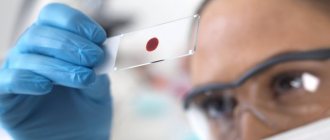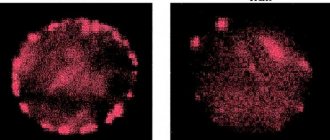Myth No. 2. You can eat an apple or drink a glass of juice before drawing blood.
In fact. No you can not.
Even a light breakfast, such as a portion of fruit or some granola, can skew research results. There are a number of mandatory food intake restrictions:
On an empty stomach: at least 4 hours after the last (not large!) meal.
Strictly on an empty stomach: at least 8 hours after the last meal. In newborns and children in the first months of life, blood sampling is allowed no earlier than 2 hours after eating.
Fasting: no food intake for at least 12 hours; fasting for more than 14 hours is not recommended.
It is advisable not to overeat 1-2 days before taking blood; if possible, exclude fatty, fried foods and alcohol from the diet. If there was a feast the day before, reschedule the laboratory test for a couple of days.
Drinking regime. Before taking blood for any type of research, it is not recommended to drink juice, tea or coffee. You can drink plain water, non-mineral and non-carbonated.
What does a biochemistry test determine?
When performing a biochemical test, the indicators identified during testing of a healthy person are taken as a standard. The material submitted for biochemistry is compared with these levels, and on the basis of this a conclusion is made about an increase or decrease in the norm.
The main components that are determined during biochemical testing:
Total protein determines the level of proteins found in the blood plasma. An increase in the norm is typical for cancer, dehydration, and acute infections. A decrease in the normal value can be observed with pathological changes in the liver, a decrease in the intake of protein foods during diets, thyrotoxicosis, chronic and acute bleeding.
Bilirubin is a product of pigment metabolism formed during the destruction of red blood cells. How much bilirubin is currently in the blood demonstrates whether the liver, spleen and metabolism in the body are functioning correctly.
An increase in indicators indicates the presence of cholecystitis, hepatitis, cirrhosis of the liver, neoplasms in the liver, pancreas or biliary tract, and anemia. Decreased levels are usually associated with the use of vitamin C or phenobarbital.
Urea is an organic substance formed after the breakdown of proteins. Often, an increase in urea levels indicates problems with the kidneys and bladder. In addition, an increase in urea levels occurs with diabetes mellitus, myocardial infarction, intestinal obstruction, internal bleeding, and dehydration. A decrease in urea in the blood is typical during pregnancy, hepatitis, liver cirrhosis, vegetarianism, raw food diet, long-term fasting, arsenic poisoning, and thyroid disorders.
Myth No. 7. Blood can be donated after x-rays and ultrasounds
In fact. No you can not. These types of studies can lead to activation of metabolic processes and distortion of research results. It is strictly not recommended to conduct laboratory tests not only after X-rays, ultrasound, but also after surgery, injections, infusions, blood transfusions, punctures and biopsies of various locations, massage, ECG, hemodialysis, ergometry, immunoscintigraphy, procedures that use ionizing radiation, endoscopic studies.
How to take a smear for cancer cells
The material is collected from the cervical canal and vaginal part with a special brush or spatula. A smear for oncocytology in our center is examined in the traditional way - transferred to a sterile glass, stained and examined.
The average duration for preparing results is 7-10 days. The collection of material does not cause pain and is carried out during a gynecological examination.
Discomfort can only be caused by the insertion of speculums, which are used to expand the view of the inside of the vagina.
How to properly prepare for a laboratory test
Share
IMPORTANT!
The information in this section cannot be used for self-diagnosis and self-treatment. In case of pain or other exacerbation of the disease, diagnostic tests should be prescribed only by the attending physician. To make a diagnosis and properly prescribe treatment, you should contact your doctor.
Dear patients! Please note that it is recommended to donate blood for laboratory tests in the morning on an empty stomach, after an 8-12 hour overnight fasting period. If the patient is unable to come to the laboratory in the morning, blood should be donated after 6 hours of fasting, eliminating fats in the morning meal.
According to the World Health Organization (WHO), laboratory tests provide 60–80% of diagnostic information about a patient. Of course, a diagnosis is not made based on just one laboratory analysis; it is compared with the clinical picture, with data from other studies and observations. Laboratory analysis suggests the direction for further search. Therefore, regular preventive examinations are the key to timely initiation of treatment, and proper preparation for tests in a modern laboratory is an accurate diagnosis.
- A number of tests are done on an empty stomach. For example, biochemical (glucose, cholesterol, bilirubin, etc.) and serological tests (syphilis, hepatitis B), hormones (TSH, parathyroid hormone), etc. “Fasting” is when at least 8 hours pass between the last meal and taking blood (preferably at least 12 hours). Juice, tea, coffee, especially with sugar, are also food, so you will have to be patient. You can drink water.
- Strictly on an empty stomach (after a 12-hour fast) you should donate blood to determine lipid profile parameters: cholesterol, HDL, LDL, triglycerides.
- If you have to take a general blood test, your last meal should be no later than 1 hour before donating blood. Breakfast may consist of unsweetened tea, unsweetened porridge without butter and milk, and an apple.
- It is advisable to exclude fatty, fried and alcohol from the diet 1 - 2 days before the examination. If there was a feast the day before, reschedule the laboratory test for 1-2 days. Avoid smoking an hour before blood collection.
- The content of many blood tests is subject to daily fluctuations, so for some studies blood should be taken strictly at a certain time of day. So, blood tests for some hormones (TSH and parathyroid hormone), as well as for iron, are given only before 10 am.
- When donating venous blood, it is necessary to exclude factors that influence the research results: physical stress (running, climbing stairs), emotional arousal. Therefore, before the procedure you should rest for 10-15 minutes in the waiting room and calm down.
- It happens that the doctor ordered a test, but for various reasons it is difficult for the patient to come to the medical office (illness, pregnancy, lack of time, etc.) In this case, it is enough to call the INVITRO Laboratory Emergency Service by calling tel. +7(495)363-03-63, and our procedural team will arrive at a place and time convenient for you.
- Blood is taken for analysis before starting to take medications (for example, antibacterial and chemotherapy) or no earlier than 10 to 14 days after their discontinuation. The exception is when they want to study the concentration of drugs in the blood (for example, valproic acid, anticonvulsants). If you are taking medications, be sure to tell your doctor about this.
- Blood should not be donated after X-rays, rectal examinations, or physical therapy procedures.
- During hormonal studies in women of reproductive age (from approximately 12 to 13 years of age and before the onset of menopause), the results are influenced by physiological factors associated with the stage of the menstrual cycle. Therefore, when preparing for examination for the hormones FSH, LH, prolactin, estriol, estradiol, progesterone, the phase of the cycle should be indicated. When conducting a test for sex hormones, strictly adhere to the recommendations of your doctor about the day of the menstrual cycle on which you need to donate blood.
- When performing tests for the presence of infections, it should be taken into account that depending on the period of infection and the state of the immune system, any patient may have a negative result. But, nevertheless, a negative result does not completely exclude infection. In doubtful cases, re-analysis is recommended.
- Different laboratories may use different research methods and units of measurement. To ensure that the assessment of your results is correct and the results are acceptable, do the tests in the same laboratory, at the same time. Comparison of such studies will be more correct.
Preparing the patient for the urine donation procedure
Collecting urine for general analysis in a container with a preservative
Collection of 24-hour urine for biochemical analysis
Urine is collected over the course of a day. The first portion of urine in the morning is removed. All subsequent portions of urine excreted during the day, night and the morning portion of the next day are collected in one container, which is stored in the refrigerator (+4. +8 ° C) during the entire collection time (this is a necessary condition, since at room temperature it is significantly glucose levels decrease). After completing urine collection, accurately measure the contents of the container, be sure to mix it and immediately pour it into a small jar (no more than 5 ml). Bring this jar to the laboratory for testing. You don't need to bring all your urine. On the referral form you need to indicate the daily volume of urine (diuresis) in milliliters, for example: “Diuresis 1250 ml”, also write down the patient’s height and weight.
Characteristics of biochemical analysis
A blood test for biochemistry is one of the methods of laboratory research, according to which one can judge whether many human organs and systems are functioning correctly . This diagnostic method is used by almost all doctors in their practice; it is used to determine pathologies of the liver, kidneys, intestines, endocrine and cardiovascular systems.
They suggest donating blood for biochemistry for the following disorders:
- liver;
- kidney;
- gastrointestinal tract;
- endocrine disorders;
- heart and circulatory system;
- musculoskeletal system.
Blood contains a large number of different substances obtained as a result of the activity of all organs and systems of the human body. By donating blood for biochemistry, you can correctly determine the level of each incoming substance, and based on these indicators, draw conclusions regarding the accuracy of the diagnosis.
For example, the amount of bilirubin in the blood can be used to determine whether a patient has liver problems. A significant increase in it indicates a violation of the standard discharge of bile, which may be a consequence of tumor formations, inflammation in the pancreas and bile ducts.
The doctor may prescribe an appropriate test to determine the diagnosis or to monitor the effectiveness of the prescribed course of treatment; in the prescription, the treating doctor independently indicates the level of which blood components need to be monitored.
Causes of low-grade fever
There are diseases that provoke a slight increase in temperature over a long period of time.
- Chronic infectious process (tuberculosis, chronic diseases of the nasopharynx, pancreatitis, cholecystitis, prostatitis, adnexitis, bacterial endocarditis, chlamydia, syphilis, HIV infection).
- Inflammatory process
- Oncology
- Autoimmune diseases (rheumatism, ulcerative colitis, drug allergies, arthritis, post-infarction syndrome)
- Parasites
- Pathologies of the endocrine system (thyrotoxicosis, severe menopause)
- Thermoneurosis (vegetative dysfunction affecting heat exchange)
If the cause of fever is an infection, then it is characterized by:
- decrease after taking antipyretic;
- poor tolerance;
- There are fluctuations throughout the day.
But there are reasons when a healthy person has a low-grade fever:
- when overheated
- under stress
- when taking certain medications
- hereditary factor, when a child is born and lives with a high temperature
- upon activation of the hypothalamus
- during pregnancy
- before menstruation.
This temperature is not susceptible to the action of antipyretic drugs, is easily tolerated and does not have pronounced daily fluctuations.
An examination will help determine the cause.
Analyzes and studies for low-grade fever.
You should always start with a general practitioner. It is the general practitioner who will refer you for initial tests, and then, after the results obtained, will recommend an appointment with a specialist: an endocrinologist, cardiologist, gynecologist, otolaryngologist, infectious disease specialist.
Hormonal examination
Doctors often refer patients to determine blood hormone levels. Most often this is done by endocrinologists and gynecologists. They may be interested in the following hormones:
- Prolactin.
- Thyroid-stimulating hormone.
- T3 and T4.
- LH and FSH.
- Estradiol.
- Progesterone.
- Testosterone.
- Adrenocorticotropic hormone.
- Insulin.
Often sick patients ask: “What will happen if I take a test against the background of a high temperature?”
It is believed that fever has virtually no effect on hormonal metabolism in the body. However, it is not. Some substances, for example, prolactin, are sensitive to stress, which is hyperthermia for the body.
The stronger the fever, the greater the likelihood of hormonal fluctuations. If a patient donates blood during this time, he or she risks getting an incorrect result.
In the case when there is a long-term low-grade fever and the level of thyroid-stimulating hormone is reduced, these two indicators are interrelated, and we are talking about increased function of the thyroid gland - hyperthyroidism, or thyrotoxicosis.
It is advisable to determine the level of hormones taking into account the woman’s menstrual cycle (relevant for sex hormones) and outside of fever.
In the case when there is a long-term low-grade fever and the level of thyroid-stimulating hormone is reduced, these two indicators are interrelated, and we are talking about increased thyroid function - hyperthyroidism, or thyrotoxicosis.
What oncocytology of the cervix shows: norm and interpretation
The essence of oncocytology is the study of the cellular composition and state of organelles - permanent components of cells. To ensure the reliability of the result, the doctor does not limit himself to taking a scraping from the vaginal part of the cervix, but takes a smear from the cervical canal for examination.
The results of the analysis are descriptive and indicate the presence or absence of cancerous or altered cells (characterizing a precancerous condition).
The term “without abnormal features” in a cytogram indicates a negative result - normal. In positive oncocytology, abnormalities can be described as changes in cell morphology, single cells with abnormalities in structure or pronounced signs of malignancy, and a large number of abnormal cells.











